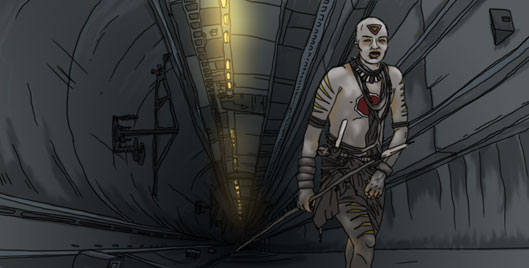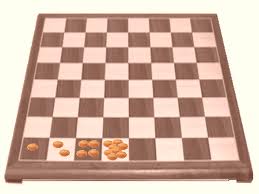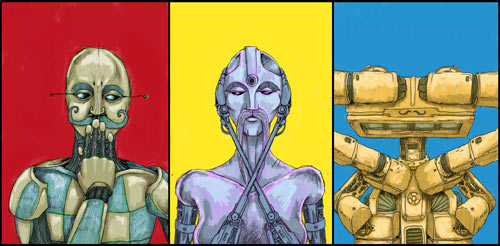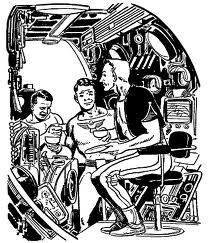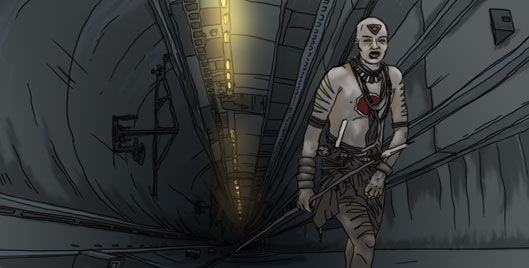And now, the fourth installment of my freshest serial, The Seventh Rule…
Month: March 2011
Controlling Time: Weapons of Math Destruction
Previous: What Have We Made?
Controlling Time: What Have We Made?
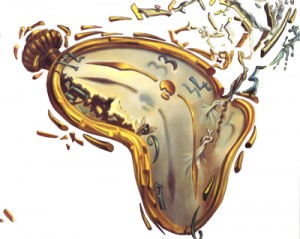 Previous: Demoed
Previous: Demoed
In 2003, two of the world’s top computer scientists introduced their latest project: Croquet. David Reed and Alan Kay proposed a radical model for making computers work together on the Internet. With co-authors David Smith and Andreas Raab (old profile!), they developed the ideas over the next three years in conjunction with teams at HP, Intel, the Japanese National Institute of Information and Communications Technology, Viewpoints Research Institute, and the Universities of Wisconsin and Minnesota. Teleplace was formed in late 2005 (originally named Qwaq) to transform this research into a practical commercial system.
And the results are in.
Continue reading
Controlling Time: Demoed
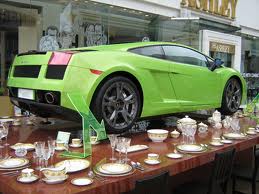 Previous: Done!
Previous: Done!
- Mobile phone and tablet access to docs, and interactive meeting participation with audio, change of viewpoint, and simple control of shared documents.
- Audio bridged to the public switched telephone network.
- The whole multi-user, multi-app realtime environment running within a single Web page.
- Automatically recording events to a tagging system.
- Connecting any objects as a concept map using stretchy light beams that you can travel along by touching them.
- Virtual glasses that let different participants see different sets of annotations on objects.
- Generating new in-world objects on-demand by sketching and painting in 2d or 3d.
- Graphical programming letting participants collaboratively program 2d and 3d behavior as they are using it.
How can all this be possible? Magic. But learnable magic.
Next: What Have We Made?
Eleven Electric Lies & The Seventh Rule — Chapter 3
Before we continue with the current serial, I’d like to mention that my latest round-up of stories is available in a new printed edition, available today via the presses of Lulu. If you still like books, or know somebody else who still likes books, or just like supporting independent publishing by putting money in the pockets of the artists you enjoy, please consider ordering a copy or two of Eleven Electric Lies: Collected Stories Volume III.
Meanwhile, here’s the third installment of The Seventh Rule…
Continue reading
Controlling Time: Done!
 Previous: Intro
Previous: Intro
Continue reading
Controlling Time: Intro
Six years ago I was hired by the University of Wisconsin to lead its development team on an internationally distributed open source project. Later a company named Qwaq was formed by project leaders and it later hired me and some of the other developers from various institutions. That company is now called Teleplace and its product sounds like science fiction, but it works. I’ve been blogging about the work since day one, and papers have been published by many people, but in the next six entries I’m going to try to bring together what I feel are the most significant accomplishments of all the various developers, and the science that has made them possible.
The Seventh Rule—Chapter 2
Without needless preamble, here is the second installment of my freshest serial, delivered in seven short parts: The Seventh Rule...
Continue reading
The Seventh Rule – Chapter 1

Today we begin new a piece, The Seventh Rule, a serialized story delivered in seven short parts.
In a break from my usual method of electronic publishing, the complete story will be available on my main site and in various eBook-friendly formats only after the last chapter has gone live via blogging/RSS. In part this is because reader Anders Hovmöller has generously created a python script that automatically discovers and converts new stories posted to my main site and I don’t want to foul the process by posting incomplete works; mostly, however, this is because formatting all the HTML pages for a chapter-by-chapter delivery is a nuissance because, unlike most denizens of the twenty-first century, I still code my pages by hand.
While we’re chatting, I should probably also mention that I’ve been invited to appear as a guest at the Toronto Comic Con, March 18 – 20, at the Direct Energy Centre. Special thanks go to Stephen Shamus for making this happen. If you’re geographically proximate I hope you’ll consider dropping by to say hello, or to offer vicious spit-flecked criticism, or whatever.
And now, without further ado, the first installment of The Seventh Rule…
The world’s best digital minds can’t be too bad
No, I’m not talking about IBM’s Watson. The Guardian has this short plug for SXSW this month. Among such uber-geek’s, note Wetmachine’s own John Sundman heading this panel. I’m very pleased to see so many women on the panel.
Controlling Time: Weapons of Math Destruction
Previous: What Have We Made?
Controlling Time: What Have We Made?
 Previous: Demoed
Previous: Demoed
In 2003, two of the world’s top computer scientists introduced their latest project: Croquet. David Reed and Alan Kay proposed a radical model for making computers work together on the Internet. With co-authors David Smith and Andreas Raab (old profile!), they developed the ideas over the next three years in conjunction with teams at HP, Intel, the Japanese National Institute of Information and Communications Technology, Viewpoints Research Institute, and the Universities of Wisconsin and Minnesota. Teleplace was formed in late 2005 (originally named Qwaq) to transform this research into a practical commercial system.
And the results are in.
Continue reading
Controlling Time: Demoed
 Previous: Done!
Previous: Done!
- Mobile phone and tablet access to docs, and interactive meeting participation with audio, change of viewpoint, and simple control of shared documents.
- Audio bridged to the public switched telephone network.
- The whole multi-user, multi-app realtime environment running within a single Web page.
- Automatically recording events to a tagging system.
- Connecting any objects as a concept map using stretchy light beams that you can travel along by touching them.
- Virtual glasses that let different participants see different sets of annotations on objects.
- Generating new in-world objects on-demand by sketching and painting in 2d or 3d.
- Graphical programming letting participants collaboratively program 2d and 3d behavior as they are using it.
How can all this be possible? Magic. But learnable magic.
Next: What Have We Made?
Eleven Electric Lies & The Seventh Rule — Chapter 3
Before we continue with the current serial, I’d like to mention that my latest round-up of stories is available in a new printed edition, available today via the presses of Lulu. If you still like books, or know somebody else who still likes books, or just like supporting independent publishing by putting money in the pockets of the artists you enjoy, please consider ordering a copy or two of Eleven Electric Lies: Collected Stories Volume III.
Meanwhile, here’s the third installment of The Seventh Rule…
Continue reading
Controlling Time: Done!
 Previous: Intro
Previous: Intro
Continue reading
Controlling Time: Intro
Six years ago I was hired by the University of Wisconsin to lead its development team on an internationally distributed open source project. Later a company named Qwaq was formed by project leaders and it later hired me and some of the other developers from various institutions. That company is now called Teleplace and its product sounds like science fiction, but it works. I’ve been blogging about the work since day one, and papers have been published by many people, but in the next six entries I’m going to try to bring together what I feel are the most significant accomplishments of all the various developers, and the science that has made them possible.
The Seventh Rule—Chapter 2
Without needless preamble, here is the second installment of my freshest serial, delivered in seven short parts: The Seventh Rule...
Continue reading
The Seventh Rule – Chapter 1

Today we begin new a piece, The Seventh Rule, a serialized story delivered in seven short parts.
In a break from my usual method of electronic publishing, the complete story will be available on my main site and in various eBook-friendly formats only after the last chapter has gone live via blogging/RSS. In part this is because reader Anders Hovmöller has generously created a python script that automatically discovers and converts new stories posted to my main site and I don’t want to foul the process by posting incomplete works; mostly, however, this is because formatting all the HTML pages for a chapter-by-chapter delivery is a nuissance because, unlike most denizens of the twenty-first century, I still code my pages by hand.
While we’re chatting, I should probably also mention that I’ve been invited to appear as a guest at the Toronto Comic Con, March 18 – 20, at the Direct Energy Centre. Special thanks go to Stephen Shamus for making this happen. If you’re geographically proximate I hope you’ll consider dropping by to say hello, or to offer vicious spit-flecked criticism, or whatever.
And now, without further ado, the first installment of The Seventh Rule…
The world’s best digital minds can’t be too bad
No, I’m not talking about IBM’s Watson. The Guardian has this short plug for SXSW this month. Among such uber-geek’s, note Wetmachine’s own John Sundman heading this panel. I’m very pleased to see so many women on the panel.




